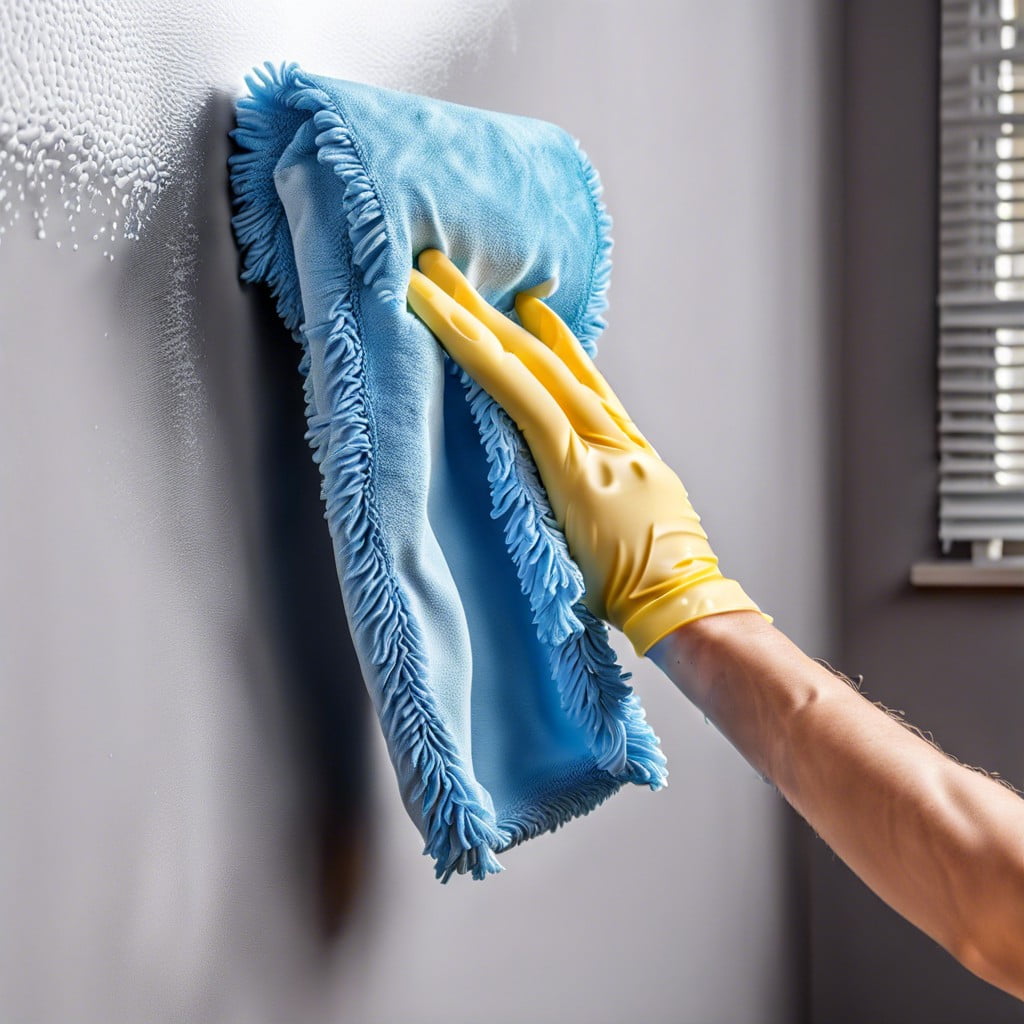Last updated on
Learn the most effective techniques to wash your walls and transform your space with minimal fuss and maximum results.
Key takeaways:
- Remove Dust before cleaning to avoid smearing dirt.
- Mix a Cleaning Solution to effectively clean painted walls.
- Wash Walls in a Circular Motion to loosen stubborn grime.
- Tackle Heavily Soiled Areas with appropriate cleaners.
- Keep Walls Clean with regular maintenance and preventative measures.
Remove Dust

Before engaging in the act of scrubbing, banishing dust from your walls is a crucial first step. Dust and dirt particles left unattended turn into muddy smears when mixed with water. Utilize a microfiber duster or cloth to gently sweep over the wall surfaces, paying extra attention to corners where cobwebs thrive. For those hard-to-reach areas, a vacuum with a brush attachment works wonders. Ceilings and baseboards shouldn’t be neglected either, as they are often the unsung heroes of wall cleanliness, harboring hidden grime that can fall onto freshly cleaned walls. This preliminary dusting act ensures that you’re not just pushing dirt around but effectively removing it, setting the stage for a truly deep clean.
Mix a Cleaning Solution
The efficacy of your wall-cleaning endeavor hinges on the solution used. For painted walls, a mixture of warm water and a drop of dish detergent works wonders, offering a mild yet effective clean. However, for a deeper cleanse, consider adding a half cup of vinegar to a gallon of water; it’s a natural disinfectant that cuts through grime without leaving any residue. Walls with wallpaper need a gentler touch; stick with a slight dab of dish soap and warm water to avoid damage. Remember that glossy or enamel surfaces can handle more robust cleaners, but always do a spot test in an inconspicuous area first. Also, never underestimate the value of plain warm water for a quick refresh or a light dirt film removal. The key is to clean without oversaturating, which can damage walls and paint.
Wash the Walls Using a Circular Motion
When tackling the actual wall washing, executing a circular motion with your sponge or cloth is paramount. This method gets into the nitty-gritty, working the solution into the surface and loosening dirt more effectively than straight-line movements. It’s not just about being thorough—it’s about physics. Circles create a more dynamic force, dislodging stubborn grime without the need for excessive pressure that can damage paint or wallpaper.
But bear in mind, it’s not about brute strength. Light to moderate pressure is the golden rule here. You want the wall clean, not stripped of its dignity. Don’t let the worry of “overdoing it” dampen your efforts, though; walls are more resilient than we give them credit for, as long as we respect their boundaries.
Dip your sponge regularly to maintain a clean surface, but avoid saturating the wall, as this can lead to water damage and a whole new set of problems you’d rather not deal with. In essence, the dance of your cloth should be a gentle waltz rather than a wild tango. It’s cleaning after all, not combat.
Tackle Heavily Soiled Areas
When facing stubborn stains, the gentle approach often won’t cut it. Here lies the challenge: removing the grime without damaging the paint.
First, identify the type of stain—grease, mold, or scuff marks each have a nemesis. Grease calls for a degreaser or a mixture of vinegar and water. For mold, a solution of bleach and water is effective, but ventilation is crucial; never mix bleach with other cleaners. Scuff marks often surrender to erasers designed for wall cleaning or a paste of baking soda and water.
Apply your chosen cleaner with a sponge, working from the bottom up to prevent drips from creating more work. Tackle one small section at a time and rinse thoroughly with a clean, damp cloth to avoid leaving any residue.
For persistent stains, patience is a virtue. It’s tempting to scrub harder, but harsh scrubbing can damage the paint. Instead, apply a little more cleaner and let it sit for a few minutes. Most stains will relent with this extra time.
Keep Walls Clean With Regular Cleaning Maintenance
Regular maintenance is the secret to walls that look freshly painted all year round. While the occasional deep clean is crucial, simple habits can prevent the build-up of dirt and grime. For instance, immediately addressing spills or marks with a damp cloth can save hours of scrubbing later. Ventilating rooms to avoid mold growth in damp areas extends the time between thorough washes. Dusting walls lightly during your weekly cleaning routine also keeps dirt from accumulating, minimizing the effort required during deep cleaning sessions. Using washable paint in high-traffic areas like kitchens and playrooms ensures that walls can withstand more frequent cleaning without losing their luster. Remember, prevention is easier than cure – keeping a consistent cleaning schedule ensures that wall washing becomes a breeze rather than a chore.
Recap




